Today every organization is facing the need to predict changes in the global business environment, to rapidly respond to competitors, and to best exploit organizational assets to prepare for growth. Your enterprise application infrastructure can either help you meet these business imperatives or it can impede your ability to adapt to change.
To proactively respond to these challenges and dynamics of change, major companies worldwide are adopting Service-Oriented Architecture (SOA) as a means of delivering on these requirements. The adoption of SOA and Business Process Management (BPM) methodologies is helping them overcome the complexity of their application and IT environments, and also aligning IT and business together. SOA represents a fundamental shift in the way new applications are designed, developed, and integrated with legacy business applications, and facilitates the development of enterprise applications as modular business services that can be easily integrated and reused.
Oracle SOA Suite 11g is a comprehensive suite of products that includes BPEL Process Modeler, Business Rules Editor, Mediator, Web Services Manager, and Business Process Manager, all designed to help build, deploy, and manage SOA and BPM-based implementations. For the full list of Oracle SOA Suite 11g components, have a look at http://docs.oracle.com/cd/E12839_01/integration.1111/e10223/01_components.htm. The deployment of the Oracle SOA Suite 11g platform within the enterprise is accelerated by the continued alignment of business and IT as a result of the rapid adoption of Service Oriented and Event Driven Architectures and Business Process Management.
While businesses strive to be more agile and dynamic, the need for administration, management, and monitoring of the underlying SOA infrastructure is essential. These are particularly important for the following reasons:
An essential aspect of any successful SOA deployment is the ability to continuously monitor mission-critical services, business processes, events, and service levels in real time to immediately identify problems and take corrective action.
SOA infrastructure monitoring provides visibility into the performance of each individual service transaction across distributed and heterogeneous systems. With this end-to-end visibility, problems could be spotted quickly and corrected to ensure reliable operations.
The SOA infrastructure is also expected to enforce policies for runtime governance.
The ability to easily and efficiently automate deployments is equally important as it enables the administrator to rapidly respond to continuous code changes.
Proper management of Service Level Agreements (SLAs) is required by defining, tracking, and controlling appropriate service levels. It also provides a necessary alert mechanism in the event of an SLA violation.
In this chapter, we will provide an overview of Oracle SOA Suite 11g monitoring and management, which ultimately serves as a prelude for the remainder of this book. Here, we will introduce various topics ranging from centralized monitoring and code deployment to performance tuning and scaling the infrastructure. This book describes each of these areas and more, in varying degrees of detail, to arm you with the necessary background and understanding, as well as detailed instructions on how to perform key administrative tasks within the Oracle SOA Suite 11g product stack. In this chapter, we will introduce the following:
Overcoming monitoring and management challenges in SOA
Monitoring the SOA platform—centralized management and monitoring
Oracle SOA Suite 11g Infrastructure Stack
Performance monitoring and management
Managing composite application lifecycles
Cloning domains from test to production
Introducing Oracle Enterprise Manager Fusion Middleware Control
The very nature of SOA involves implementation of services that are distributed and loosely coupled, and thus monitoring these services is complex due to the involvement of disparate systems that may include external systems and external resources (for example, messaging queues, databases, and so on). Tracing transactions across a loosely coupled implementation, particularly if it involves invocations to external systems, is extremely complicated. The reusable nature of SOA increases the importance of managing availability and performance of these services and greatly increases the need for closed loop governance. In order to achieve the desired Quality of Service (QoS), each service endpoint must literally be managed like a resource. Managed services should have near zero downtime, performance metrics, and a defined service level agreement. In a composite service's infrastructure, it's necessary to monitor and manage the end-to-end view of the systems, as well as provide detailed information about the performance and availability metrics of individual services. Each part of the overall SOA system can appear healthy while individual service transactions can be suffering.
Another important aspect of SOA monitoring is logging. The distributed nature of SOA makes a standardized logging approach difficult to implement. In addition to monitoring services in real time, the administrator is also required to perform standard administrative duties such as backups, code deployments, performance tuning, purging of old data, and more. In general, SOA infrastructure administrators are swamped with the following tasks and activities:
Managing multi-tier transaction flows
Spanning shared components/services
Deployed across several tiers in different containers
Across the enterprise
Obtaining performance metrics and visibility into SOA services
Beyond generic Java classes and methods
Framework and metadata visibility
Specific knowledge of the Oracle platform
Maintaining control over configuration changes
Performance tuning the service infrastructure
Performing time consuming administrative tasks
Code deployments
Cloning and scale up
Backups and restores
Purging and cleanup
Troubleshooting faults and exceptions
Policy and security administration
This book is intended to provide you, the Oracle SOA Suite 11g administrator, with a thorough understanding of how to perform each of these tasks and activities.
Monitoring in Oracle SOA Suite 11g enables closed loop governance by connecting design-time with runtime. Once services, their metadata, and associated policies are deployed, they begin to be automatically monitored and managed by the service infrastructure by regularly updating the console with a scorecard of runtime metrics collected.
Oracle SOA Suite 11g runs on top of numerous infrastructure components that include database management systems, J2EE compliant application servers and centralized identity management solutions. All Oracle SOA Suite 11g components have specific functions for administering and managing parts of an SOA infrastructure, each from a different perspective or for a different audience. In order to address the monitoring and management challenges described earlier, several areas need to be considered:
Monitoring solutions need to be provided at an enterprise level that encompass all related applications. This can begin with monitoring composite endpoints as well as the overall operational health of the infrastructure.
Real-time monitoring and proactive alerting based on runtime statistics of configured KPIs, availability, performance metrics, and service level agreements should be implemented.
Reporting of important information in the message (that is, payload), captured as a part of reporting functionality, can aid system administrators in better analysis and troubleshooting.
Oracle Enterprise Manager Fusion Middleware Control, the web-based console into all Oracle SOA Suite 11g administrative functions, enables a bird's-eye view of your processes and their instances through a centralized management and monitoring console. It organizes a wide variety of performance data and administrative functions into distinct, web-based home pages. These home pages make it easy to locate the most important monitoring and performance data, and the most commonly used administrative functions for any Fusion Middleware component—all from your web browser!
Via Oracle Enterprise Manager Fusion Middleware Control, you can browse running servers, applications, and service engines to easily recognize and troubleshoot runtime problems in the SOA platform. As depicted in the following screenshot, the dashboard provides a comprehensive snapshot of the environment, including recent composite instances, state of currently deployed composites, and recently faulted transactions and their errors. From here, we typically drill down as necessary.

With out-of-the-box functionality provided by Oracle Enterprise Manager Fusion Middleware Control, you can obtain a real-time end-to-end view of the business transaction for SLA management, fault tracing, and problem determination, including the following:
Web services message processing totals and processing times
Transaction discovery/availability/state/status
Transaction performance
SOA registry and security
Service discovery and relationship/dependency mapping
Transaction audit trail and flow, faults, and rejected messages
JMX-based monitoring of all components of the SOA infrastructure
In addition, Oracle Enterprise Manager Fusion Middleware Control provides a comprehensive infrastructure management console that includes the following capabilities:
Code deployment and undeployment
Startup and shut down
Performance, metrics, and transaction monitoring
Security and policy management
Log management
Instance monitoring and management
Runtime exceptions and fault management
Diagnostics and tuning
Browsing, viewing, and modifying runtime MBeans
Web service testing
The following diagram shows the runtime architecture of Oracle Enterprise Manager Fusion Middleware Control. It describes how Oracle Enterprise Manager Fusion Middleware Control aggregates runtime metrics from different components.
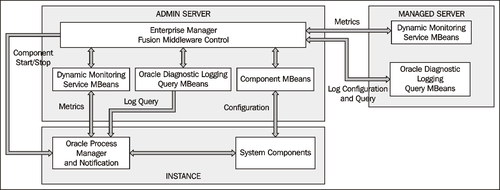
Several internal services are leveraged to automatically collect these metrics behind the scenes:
Oracle Process Manager and Notification (OPMN): OPMN is responsible for aggregation of component status, runtime metrics, and component logs, and provides a central access point for this information. It can also act as an agent that can start/stop registered components.
Dynamic Monitoring Service (DMS): DMS hooks up with the runtime MBeans of all participating managed servers controlled by Oracle Enterprise Manager Fusion Middleware Control. This MBean periodically collects performance and monitoring statistics for all available components, and makes it available for the DMS collection MBeans on the Admin Server.
Oracle Diagnostics Logging (ODL): ODL is a standard Java API utility framework that is leveraged in Oracle Enterprise Manager Fusion Middleware Control to log diagnostic messages in a standard format across each domain.
Apart from Oracle Enterprise Manager Fusion Middleware Control, there are a host of other management and monitoring frameworks available to administer various facets of your SOA infrastructure to help pinpoint issues. This includes JRockit Mission Control, WebLogic Diagnostics Framework (WLDF), Weblogic Scripting Tool (WLST), Oracle Enterprise Manager Grid Control, and more. Although these frameworks and tools are beyond the scope of this book, the following diagram provides a holistic view of each of these frameworks:
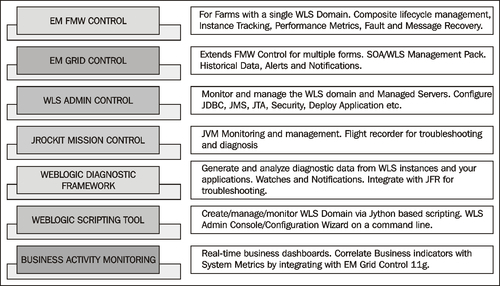
Oracle SOA Suite 11g is a member of the Oracle Fusion Middleware family of products. Oracle has put in the effort to make this stack robust, extensible, and agile, in part by including some of the best technologies available on the market. Instead of cobbling together enterprise solutions from disparate vendors and products, Oracle SOA Suite 11g provides you with a unified product suite to meet all of your SOA needs. This results in a single design-time experience, single runtime infrastructure, and end-to-end monitoring that greatly simplifies the building, maintenance, and monitoring of distributed SOA implementations.
The following diagram shows how Oracle SOA Suite 11g brings out a seamless integration capability for an enterprise wide SOA adoption and implementation by using an array of standard components suited to achieve a specific business objective:

Here are some points about the Oracle SOA Suite 11g infrastructure stack:
JDeveloper provides a design and development environment for software developers and architects, using the Oracle SOA Suite 11g to create standards based reusable enterprise software assets.
Service components can be built as BPEL and/or BPMN processes, business rules and decision components, human task, events and mediator, or a combination thereof. They are the building blocks used to construct SOA composite applications. The service infrastructure, comprising a unified platform for services, processes, and events, provides the internal message transport infrastructure capabilities for connecting service components and enabling data flow. Service engines, such as the BPEL Process Manager Engine, Mediator Engine, and BPM Engine, process messages received |from the service infrastructure.
Oracle Service Bus provides a framework for lightweight, scalable, and reliable service orchestration designed to connect, mediate, and manage interaction between heterogeneous systems and services. It is widely adopted in all major SOA implementations, and is used to transform protocols and messages between different components.
Oracle Business Activity Monitoring (BAM) is used to build interactive real-time dashboards and proactive alerts for monitoring business processes and services, giving business executives and operation managers the information they need to take corrective action, if the business environment changes.
Oracle Business-to-Business (B2B) Integration enables integration with trading partners by using industry standard protocols such as RossettaNet, Electronic Data Interchange (EDI), and so on, to provide a solution for establishing online collaborations and automated processes.
Oracle Complex Event Processing (CEP) provides a mechanism to process multiple event streams to detect patterns and trends in real time, and provide enterprises the necessary visibility via BAM. Oracle CEP is designed to look across discrete event streams to find only the important events/trends within a given time frame, and to detect missing events and events that should have occurred but did not.
Oracle Web Services Manager (OWSM) is used to govern interactions with shared services through security and operational policy management and enforcement to ensure service reuse remains under control. Starting with the Oracle SOA Suite 11g release, OWSM is a component that is built into the suite. Every Oracle SOA Suite 11g domain has this component built-in by default to facilitate the management of web services.
Oracle SOA Suite 11g relies on 100 percent standard integration approaches using BPEL, BPMN, JCA, J2EE, and web services, and hence extending its reach to other service-based and process-centric applications. This makes it highly pluggable with your existing enterprise IT infrastructure. Oracle SOA Suite 11g can be installed to run on any number of standards compliant application servers including Oracle WebLogic Server, IBM WebSphere, and Red Hat JBoss, and can run on any number of certified database management systems such as the Oracle Database, IBM DB2, and Microsoft SQL Server.
What differentiates Oracle SOA Suite 11g from other comparable products on the market is the consolidation of the stack into a unified service platform that translates into major user benefits. Service Component Architecture (SCA), an emerging standard, is the key enabler here. SCA enables you to manage, version, and deploy components and metadata as a single unit. All artifacts are stored in a single repository, the Metadata Store (MDS). But the story doesn't stop here, Oracle SOA Suite 11g also consolidates all the runtime into a modular architecture of engines plugging into a common service infrastructure. And the engine consolidation naturally leads to a rationalization of the monitoring infrastructure, still maintaining a vendor neutral J2EE platform! All of this translates into numerous design-time, runtime, and monitoring benefits, many of which we will explore throughout this book.
Performance means different things to different people. For some, it translates to transaction response time, while others view it as the volume of work that can be processed within a given time period. In order to maximize performance, you will need to monitor, analyze, and tune all of the components that make up your application and infrastructure.
Performance of your SOA composites can be directly impacted by the design and implementation of the SOA code itself, the setting and configuration of the service infrastructure, or performance of external resources such as services or queues. Where do you begin to identify the performance bottleneck?
Fortunately, Oracle Enterprise Manager Fusion Middleware Control provides a single tool that you require to capture key information such as WebLogic Server performance statistics and composite performance details. The following screenshot highlights the capturing of performance snapshots by using Oracle Enterprise Manager Fusion Middleware Control:

It is also important to understand that performance tuning is an iterative process. You need to make the adjustments, measure the impact, and then perform an analysis before possibly making further adjustments, and so on. Due to the varying expectations of a performant system, there is no one-size-fits-all solution that works well in every environment. Improving performance is a process of learning and testing.
Chapter 4, Tuning Oracle SOA Suite 11g for Optimum Performance provides detail on how to tune the performance of the Oracle SOA Suite 11g service infrastructure. It will describe the various knobs that you can adjust, and when and how you might want to adjust them. It is not unusual to obtain considerable performance gains by implementing certain settings or applying specific configurations. Though tuning the service infrastructure is not the only area that impacts performance, it is undoubtedly a key area.
The typical software development lifecycle is comprised of multiple phases such as requirements, analysis, design, development, testing, and promotion. Within the Oracle SOA development lifecycle, deployment and runtime management tend to introduce certain complexities. As an SOA composite is being developed, it may reference an endpoint (effectively a fully qualified URL) on a development server. This reference will need to change as the composite is promoted to higher up environments such as test and production. For example, your developers may have developed code that processes payments against PayPal. Naturally, they would be pointing to the PayPal sandbox server at https://api.sandbox.paypal.com/2.0/ during development. What happens when this code is deployed to production? How are these references automatically updated to reference the PayPal production servers?
Oracle SOA Suite 11g offers comprehensive lifecycle management features starting from development, packaging, deployment, and post-deployment:
It offers the ability to deploy multiple versions of a given composite application and specify a default version from either JDeveloper, Oracle Enterprise Manager Fusion Middleware Control, or ant/WLST-based scripts.
Oracle SOA Suite tooling allows you to make/compile your composite applications and export a deployable SOA archive (SAR).
It has built-in capabilities to connect with versioning systems to version control your composite artifacts.
It offers configuration plans that are composite-wide to customize environment specific values, such as a web service URL that is different in the dev/test environment than in the actual production environment. With configuration plans, here are a few things you can modify:
WSDL and schema includes/imports and endpoints
Endpoints and imports in
composite.xmlAdapter properties
Web Service Policies can be attached/detached to either composite endpoints
The following screenshot illustrates how a developer IDE such as JDeveloper (top-left) is used to build and compile SOA composites that can eventually be packed and deployed as a JAR file to the Oracle SOA Suite 11g infrastructure for execution. The composites along with their instances can be instantaneously managed and monitored from the Oracle Enterprise Manager Fusion Middleware Control console (bottom-left).

For managing your complete end-to-end lifecycle, you can also consider an enterprise repository solution such as the Oracle Enterprise Repository (OER), which integrates with JDeveloper and related tools. It provides a system of record for all SOA asset information, automatically detects usage of these artifacts, tracks compliance, as well as many other governance capabilities and features. OER focuses on the SOA governance aspect of the lifecycle, but is not part of Oracle SOA Suite 11g or its infrastructure. Additional information on Oracle Enterprise Repository can be found at http://www.oracle.com/technology/products/soa/repository/index.html.
One of the key principles of SOA is that systems are no longer built to last, but rather built to change. As an administrator of the Oracle SOA Suite 11g platform, you should expect more rapid and continuous changes by development teams in response to ever changing business requirements.
Being able to adapt to the changing business requirements is not only important once a system has gone live, but it is also equally important during development. This would mean expecting a greater number of builds, packaging, and deployments. The process of deployment involves piecing together multiple relevant components, compiling them, deploying the final package into a target environment, and finally running a series of tests to validate the build. This would have to be repeated in each environment until promoted to production. This process is manual, resource intensive, and highly error prone.
Note
Automating application deployments is a practice that is widely adopted within the software industry to alleviate manual, resource intensive, and highly error prone processes.
Oracle SOA Suite 11g is unique in that it provides several ant scripts to assist in the compilation, build, and deployment of composites. These scripts can be executed manually, automated through custom scripts, or used from a continuous integration tool such as Hudson. As you read on, Chapter 2, Management of SOA Composite Applications of this book will cover details of how you can automate your composite build and deployment with ant scripts.
Think of a script which runs at regular time intervals or at the click of a button every time an administrator needs to deploy an application to the platform. By having automated build reports detailing the execution and/or issues of compilation and deployment, your time is freed up considerably to focus on other administrative activities. The following screenshot shows the continuous integration with the Oracle SOA Suite 11g platform:
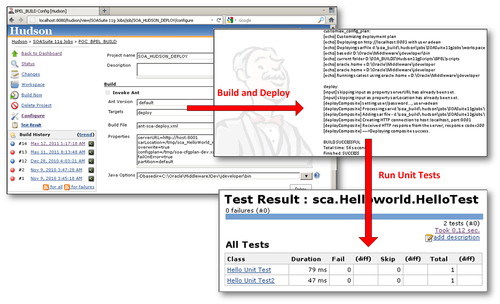
The preceding screenshot shows the Hudson console for a build job and the output of an automated build, which is followed by an automated unit test. By leveraging continuous integration tools such as Hudson, the deployment and validation efforts required by the Oracle SOA Suite administrator are greatly reduced.
Oracle SOA Suite 11g enables administrators to further minimize manual steps involved when moving the domain infrastructure across physical machines. It allows what is referred to as green field movement, which entails leveraging existing out-of-the-box tools and capabilities to perform this activity without the reliance on external or third-party tools.
The following diagram depicts, at a high level, the process involved when moving Oracle Fusion Middleware components. This minimizes the amount of work that would otherwise be required to reapply all the customization and configuration changes made in one environment to another. You can install, configure, customize, and validate Oracle Fusion Middleware in a test environment. Once the system is stable and performs as desired, you can create the production environment by moving a copy of the components and their configurations from the test environment, instead of reimplementing all the changes that were incorporated into the test environment.

Installed binaries and patches
Configuration and metadata
Security configuration (for example, OPSS policies)
Supports MDS metadata and JCA connection factories
MovePlan—rewiring external references to match target
Data sources and endpoint addresses
Oracle Enterprise Manager Fusion Middleware Control is the Oracle SOA Suite 11g administrator's primary console to perform all necessary monitoring, management, and deployment activities. This includes administering areas such as the SOA infrastructure, composite applications, partitions, Java EE applications, and more. Through the console, you can perform the following functions:
Create and delete partitions to provide a logical grouping of composites
Manage composite state, including starting, stopping, activating, retiring, and setting the default revision of a deployed composite
Manage composite instances, including deleting, terminating, and in some cases recovering instances
Deploy and undeploy composites
Export a composite or its metadata to a JAR file
Automate unit testing
Manual testing of composite applications
Attach policies to composites, service components, and binding components
Manage human workflows and notifications
Publish or subscribe to business events
Publish web services to a Universal Description, Discovery and Integration (UDDI) registry such as Oracle Service Registry
Subsequent chapters delve into each of these areas in varying levels of detail.
To log in to the Oracle Enterprise Manager Fusion Middleware Control, simply navigate to the following URL in your web browser:
http://<host>:<port>/em
The default port for HTTP is 7001 and the default port for HTTPS is 7002, though this depends on the settings used during the installation. The default username is weblogic and the password is the one provided at installation or subsequently changed.
After logging in to the Oracle Enterprise Manager Fusion Middleware Control, the vertical navigation tree on the left, or the navigator, is your primary means to navigating to all other areas within the console. Here, you can right-click on many, but not all, menu items to pop up additional navigation menus. The navigator is the leftmost column as shown in the first screenshot under the Presenting the dashboards section.
Once you log in to Oracle Enterprise Manager Fusion Middleware Control, you are presented with the overall server state in a dashboard format. As shown in the following screenshot, deployment statuses are summarized in a pie chart, indicating a summary of the composites that are up, down, or in an unknown state. The state of deployed Java EE applications and infrastructure components are also shown. For example, out-of-the-box SOA Suite Java applications such as the BPM Composer (see BPMComposer in the following screenshot) are shown to have an up status. These Java applications, for example, are additional consoles and capabilities that are installed as part of Oracle SOA Suite 11g.
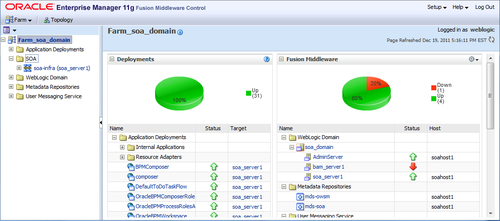
This dashboard is particularly useful to quickly and immediately get a snapshot of the overall health of the system.
On the navigation tree, when you expand SOA and click on soa-infra, you are presented with the SOA Infrastructure dashboard, which includes recent composite instances, deployed composites, and recent faults and rejected messages. By clicking on the various tabs, you are taken to a more detailed view.
For example, the Instances tab would show all instances, not just the recent ones. Clicking on the instance ID will pop up a new window, displaying the flow trace of that particular instance as shown in the following screenshot:
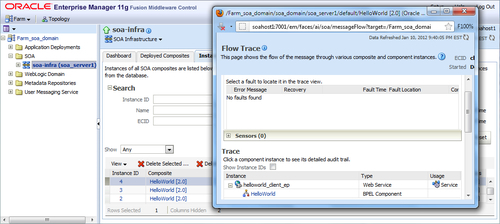
Oracle Enterprise Manager Fusion Middleware Control allows you to configure areas of the SOA Infrastructure and service engines. This is done by expanding SOA in the navigator and right-clicking on soa-infra:
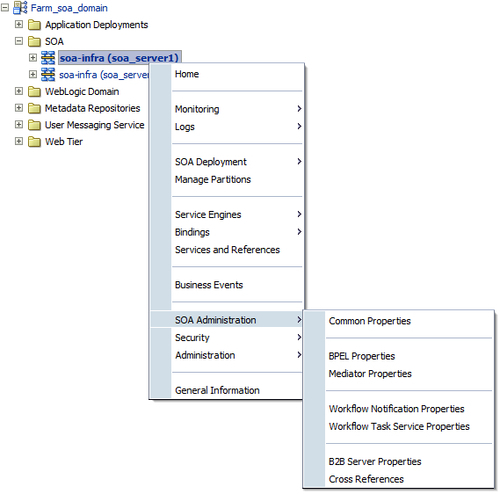
By expanding the SOA Administration menu as shown in the preceding screenshot, the various menu options will allow you to perform a number of configurations and setups on various SOA Infrastructure components and service engines that include the following.
Common Properties: Here, you can modify server settings that impact the entire infrastructure. This includes global audit levels, capturing the state of composite instances, performing payload validation, configuring callback URLs, setting UDDI registry properties, setting retry counts, Enterprise Manager Fusion Middleware Control console optimization parameters, and more.
BPEL Properties: This page provides the ability to set the maximum document size for a variable, enable or disable payload validation, disable sensors, configure BPEL Service Engine properties such as dispatcher system threads, invoke threads, engine threads, and more.
BPMN Properties: This page provides the ability to set the audit trail size, set the maximum document size for a variable, enable or disable payload validation, configure dispatcher system threads, invoke threads, engine threads, and more.
Mediator Properties: This page provides options for setting the audit level, DMS metrics level, number of parallel worker threads, number of maximum rows retrieved for parallel processing, parallel thread sleep values, error thread sleep values, and more.
Workflow Notification Properties: Here, properties such as the workflow service notification mode and actionable e-mail address, and more, can be set for human workflow notifications.
Workflow Task Service Properties: This page provides the ability to configure the actionable e-mail account, add the URL of the worklist application, select the pushback assignee, add portal realm mapping, and more.
Cross References: This page provides options for selecting cross-reference values.
By expanding Application Deployments on the navigator, a list of deployed Java EE applications is shown. In parentheses, the managed server that this application is targeted to is shown. For example, the composer application is targeted to the AdminServer. The default applications installed with Oracle SOA Suite 11g include:
soa-infra
BPMComposer
composer
DefaultToDoTaskFlow
OracleBPMComposerRolesApp
OracleBPMProcessRolesApp
OracleBPMWorkspace
SimpleApprovalTaskFlow
worklistapp
When expanding Application Deployments | Internal Applications, a further list of applications is shown. The default internal applications installed with Oracle SOA Suite 11g include:
b2bui
DMS Application
em
FMW Welcome Page Application
wsil-wls
It is fairly common to deploy additional Java applications and target them to the SOA Server (for example, soa_server1) such as Java web services designed to supplement your SOA code, although it is probably recommended to dedicate a separate managed server for them. Java applications can be deployed either through Oracle WebLogic Server Administration Control or Oracle Enterprise Manager Fusion Middleware Control.
Oracle SOA Suite 11g includes many other application and server specific consoles. The two consoles we mainly focus on in this book are the Oracle Enterprise Manager Fusion Middleware Control and WebLogic Server Administration Console. The WebLogic Server Administration Console is used to administer all application server areas such as Java/JEE application deployments, managed server setup, configuration, and started, security, resource management, and much, much more. We will go over key areas of the WebLogic Server Administration Console in this as well as other chapters of the book. It can be accessed at (default port is 7001) http://<host>:<port>/console.
Other consoles include the SOA Composer, which is used to manage business rules, domain value maps (DVMs), and tasks. The console can be accessed at (default port is 8001) http://<host>:<port>/soa/composer.
The BPM Worklist is where users (including business users) can view and manage all workflows and tasks delegated to them. The console can be accessed at (default port is 8001) http://<host>:<port>/integration/worklistapp.
The BPM console is used to manage users, partners, agreements, documents, and channels required for your B2B integrations. The console can be accessed at (default port is 8001) http://<host>:<port>/b2b.
The BAM console includes three separate functional areas—the BAM Architect, BAM ActiveStudio, and BAM ActiveViewer. These are used to create BAM users and data objects, create reports, and view reports. The console, which is only supported with Microsoft Internet Explorer, can be accessed at (default port is 9001) http://<host>:<port>/OracleBAM.
In this chapter, we provided a snapshot of some of the important aspects of Oracle SOA Suite 11g administration and the capabilities that can be leveraged to effectively manage and monitor the SOA infrastructure.
To summarize this chapter's key takeaways:
One of the main challenges of monitoring an SOA infrastructure is the need to obtain an end-to-end view of loosely coupled services that may span multiple disparate systems.
Oracle SOA Suite 11g is a complete, integrated, best-of-breed, and hot-pluggable product set that helps to deliver robust, agile, and reliable SOA solutions.
Oracle SOA Suite 11g is 100 percent standards-based, and can run on any number of J2EE application servers (for example, WebLogic Server, WebSphere, and JBoss) and certified database management systems (for example, Oracle database, DB2, and SQL Server).
Oracle Enterprise Manager Fusion Middleware Control allows you to both manage and monitor all components and services within the Oracle SOA Suite 11g stack, from a single web-based console.
OPMN, DMS, and ODL are internal services used to automatically gather and aggregate metrics that are ultimately reported by Oracle Enterprise Manager Fusion Middleware Control.
Deployment of SOA code is often one of the more challenging activities an administrator faces, but through the use of configuration plans and out-of-the-box ant scripts shipped with Oracle SOA Suite 11g, this task is finally made easier.
Oracle SOA Suite 11g has been designed to allow easy integration with continuous integration tools and engines by provisioning out-of-the-box build, deploy, and management scripts.
Oracle SOA Suite 11g provides the ability to move test to production environments easily, without the need to rely on external or third-party tools. Administrators no longer have to reapply configurations or customizations when building higher up environments.
Chapter 2, Management of SOA Composite Applications, dives deeper into the management aspects of Oracle SOA Suite 11g that were briefly touched upon here:
Focusing on managing composites
Leveraging ant for automated deployments
Promoting code by using Oracle SOA Suite 11g's new configuration plan feature
Delving into a comprehensive discussion on audit levels




















